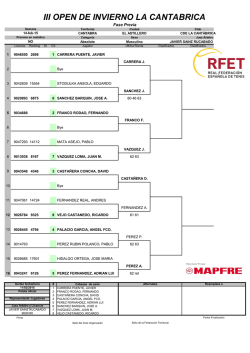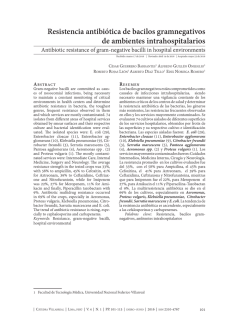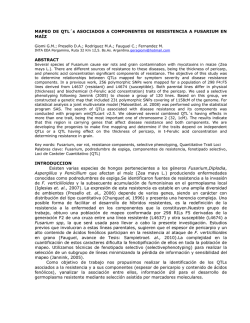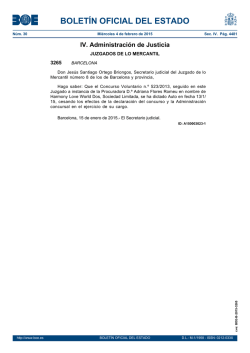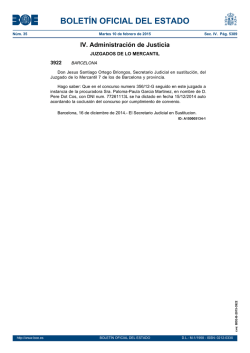
Memoria Científica del Grupo - Centro de Investigaciones Biológicas
Biología Medioambiental | Environmental Biology Pedro Castañera Domínguez Félix Ortego Alonso Profesor de Investigación [email protected] Investigador Científico [email protected] Ph.D. Entomology, 1993 University of Arizona (Tucson, USA) M.Sc. Entomology, 1977 University of London (UK) Ph.D. Ingeniero Agrónomo, 1981 Universidad Politécnica de Madrid Postdoctoral, 1994-1997 Científico Titular, 1997 Investigador Científico, 2003 Vicedirector, 2008-2009 y 2012-2013 Vocal Comisión de Ciencias Agrarias, 20082012 CIB, CSIC Visiting professor, 1992-1993 Cornell University (Ithaca, USA) Coordinador Científico Técnico del Área de Ciencias Agrarias, 1991-1992 Vocal Comisión de Ciencias Agrarias, 1993-2004 Vicedirector CIB, 2002-2008 CIB, CSIC Investigadores del equipo | Staff scientists: Pedro Hernández Crespo http://www.cib.csic.es/es/grupo.php?idgrupo=36 Gema María Pérez Farinós Otros miembros | Other lab members: José Cristian Vidal Quist María Luisa Ruiz Serra Beatriz Beroiz Remírez Matías García García Carolina Navas Jiménez Ángel Luis Garvía Rodríguez Francisco Couso Ferrer Nuria Arranz de Pablo Natalia A. Perera González Gabriela Fernández-Mata Rodríguez María Arias Martín Miguel González Ximénez de Embún Ana Martín Camargo María Estrella Santamaría Fernández Candy Monserrat Romero Origel Suzy Widen Machado Interacción Planta-Insecto El objetivo del grupo es conocer los efectos del estrés biótico y/o abiótico sobre la interacción planta-artrópodo, con especial atención a retos de la globalización (especies invasoras) y el cambio climático (estrés hídrico). La composición del grupo permite un abordaje integral para proponer nuevas estrategias en el Manejo Integrado de Plagas, una herramienta esencial para conseguir una mayor seguridad alimentaria, calidad ambiental y salud. L as investigaciones actuales son: A) Uso sostenible del maíz transgénico (maíz Bt). La mayor preocupación del cultivo de maíz Bt es el desarrollo de resistencia de las plagas diana, Sesamia nonagrioides y Ostrinia nubilalis. Desde 1998 estamos realizando un seguimiento de la evolución de la resistencia al maíz Bt. Además, hemos estudiado la biología, genética y fisiología de S. nonagrioides y la resistencia al maíz Bt de la plaga secundaria Mythimna unipuncta. Esta información permitirá el desarrollo de modelos para predecir la evolución de la resistencia al maíz Bt y efectuar un adecuado manejo de la misma. Por otra parte, hemos analizado los efectos del maíz Bt sobre artrópodos no-diana A y su exposición a toxinas Cry, y evaluado la presencia de hongos micotoxígenos en maíz Bt y no-Bt y su relación con los niveles de fumonisinas. B) Resistencia a insecticidas en Ceratitis capitata. Hemos encontrado resistencia a malatión y λ-cialotrina en poblaciones de campo de esta plaga, una de las más importantes de cítricos en España. En base a los múltiples mecanismos de resistencia encontrados, estamos desarrollando herramientas biotecnológicas para la detección precoz de resistencia, y la toma de decisiones de tratamientos en campo. C) Efecto combinado de estrés abiótico (sequía) y biótico (ácaros) sobre daños a cultivos. El B cambio climático puede reducir los recursos hidrícos disponibles para cultivos de regadío. Estamos, pues, estudiando los efectos de plantas de tomate sometidas a estrés hídrico sobre el desarrollo/daño de plagas clave de ácaros (Tetranychus spp. y Aculops lycopersici) en este valioso cultivo. D) Fisiología y biología molecular de ácaros causantes de alergia. Hemos desarrollado un sistema para la identificación molecular de especies de ácaros del polvo, estudiamos la expresión de alergenos en respuesta a los cambios en el entorno, y estamos desarrollando nuevos métodos para la estandarización de extractos alergénicos que se utilizan en inmunoterapia. Figura 1 | Figure 1 Dos de los grupos seleccionados para evaluar los efectos del maíz Bt en microartrópodos del suelo: colémbolos (A) y oribátidos (B). Two of the selected groups used to assess the effects of Bt maize on soil microarthropods: springtails (A) and oribatids (B). Financiación | Funding • AGL2013-42632-R (MINECO) • AGL2012-34289 (MINECO) • AGL2010-21349-C02-01/AGR (MICINN) • VAPC20124302 (ALK-Abelló) • VATC20123550 (Monsanto Europe SA.) 46 02 _ DPTO BIOLOGIA MEDIOAMBIENTAL _ 15-06-24.indd 46 24/6/15 12:27 The aim of the group is to understand the effects of biotic and/or abiotic stress on arthropod-plant interaction, giving special attention to the new challenges related to globalization (invasive pests) and climatic change (water stress). The multidisciplinary composition of the group allows a holistic approach to offer innovative methods for Integrated Pest Management (IPM), a key issue to food security, environmental quality and public health. O ur current research is focused on: A) Sustainable use of transgenic maize (Bt-maize). Field-evolved resistance of the targeted maize pests Sesamia nonagrioides and Ostrinia nubilalis is the major concern for the sustainable use of Bt maize. Since 1998, we are monitoring the evolution of the susceptibility of these corn borers to Bt-maize. Moreover, we are studying the biology, genetics and physiology of S. nonagrioides, and the resistance of the secondary pest Mythimna unipuncta. All this information is paving the way for modelling pest resistance and developing resistance management strategies in maize. Furthermore, we assess the effects of Bt maize on non-target arthropods and their exposure to Cry toxins through different trophic linkages. We also evaluate the occurrence of micotoxigenic fungi in Bt vs. non-Bt maize ears and its relationship with fumonisin levels. B) Insecticide resistance in the Mediterranean fruit fly. We have found field-evolved resistance to malathion and λ-cyhalothrin in this major pests of citrus and other fruit crops in Spain. Based on the knowledge of the multiple resistance mechanisms found, we are developing biotechnological tools for the early detection of resistance, and to assist sound decisionmaking on field treatments. C) Combined effects of abiotic (drought) and biotic (mites) stress on crop damage. As a con- A B sequence of climate change, less water availability is expected for summer-irrigated crops. We are investigating the effects of tomato drought-stress plants on the performance/ damage of economically important mite pests (Tetranychus spp. and Aculops lycopersici) on this major horticultural crop. Biología Medioambiental | Environmental Biology Insect-Plant Interaction D) Studies on the physiology and molecular biology of allergy producing mites. We have developed molecular tools for species identification, we are also studying allergen expression in mites in response to the environment, and we are developing new methods for the standardization of allergenic extracts used in immunotherapy. Figura 2 | Figure 2 Evaluación del desarrollo de las arañas rojas Tetranychus evansi (A) y T. urticae (B) en plantas de tomate sometidas a estrés hídrico. Assessment of the performance of the spider mites Tetranychus evansi (A) and T. urticae (B) on tomato drought-stress plants. Publicaciones Seleccionadas Selected Publications • Arouri R, Le Goff G, Hemdem H, Navarro-Llopis V, M’Saad M, Castañera P, Feyereisen R, Hernández-Crespo P, Ortego F [2015] Resistance to lambda-cyhalothrin in Spanish field populations of Ceratitis capitata and metabolic resistance mediated by P450 in a resistant strain. Pest Manag Sci, DOI 10.1002/ps.3924. • Vidal-Quist JC, Ortego F, Lombardero M, Castañera P, Hernández-Crespo P [2015] Allergen expression in the European house dust mite Dermatophagoides pteronyssinus throughout development and response to environmental conditions. Med Vet Entomol, doi: 10.1111/mve.12102. • Juan-Blasco M, Sabater-Muñoz B, Pla I, Argilés R, Castañera P, Jacas JA, Ibáñez-Gual MV, Urbaneja A [2014] Estimating SIT-driven population reduction in Mediterranean fruit fly from sterile mating. Bull Entomol Res 104:233-242. • Beroiz B, Couso-Ferrer F, Ortego F, Chamorro MJ, Arteaga C. Lombardero M, Castañera P, Hernández-Crespo P. [2014] Mite species identification in allergenic extract production for clinical use and in environmental samples by ribosomal DNA amplification. Med Vet Entomol 28:287-296. • San Andrés V, Ayala I, Abad MC, Primo J, Castañera P, Moya P [2014] Laboratory evaluation of the compatibility of a new attractant contaminant device containing Metarhizium anisopliae with Ceratitis capitata sterile males. Biol Control 72:54-61. • Monzó C, Juan-Blasco M, Pekar S, Molla O, Castañera P, Urbaneja A [2013] Preadaptive shift of a native predator (Araneae, Zodariidae) to an abundant invasive ant species (Hymenoptera, Formicidae). Biol Invasions 15:89-100. • Juan-Blasco M, Sabater-Munoz B, Argiles R, Jacas JA, Castañera P, Urbaneja A [2013] Molecular tools for sterile sperm detection to monitor Ceratitis capitata populations under SIT programmes. Pest Manag. Sci 69:857-864. • Gonzalez-Cabrera J, García M, Hernández-Crespo P, Farinós GP, Ortego F, Castañera P [2013] Resistance to Bt maize in Mythimna unipuncta (Lepidoptera: Noctuidae) is mediated by alteration in Cry1Ab protein activation. Insect Biochem Mol Biol 43:635-643. • Crava CM, Farinós GP, Bel Y, Castañera P, Escriche B [2013] Quantitative genetic analysis of Cry1Ab tolerance in Ostrinia nubilalis Spanish populations. J Invertebr Pathol 113:220-227. • Hernández-Crespo P, Beroiz B., Castañera P, Ortego F, Chamorro MJ, Lombardero M, Arteaga C. Molecular identification of allergy causing mites by PCR. European priority: EP13176734.5 – 1404, Internacional priority: PCT/EP2014/065276. Owner: ALK-ABELLÓ. 47 02 _ DPTO BIOLOGIA MEDIOAMBIENTAL _ 15-06-24.indd 47 24/6/15 12:27
© Copyright 2025
